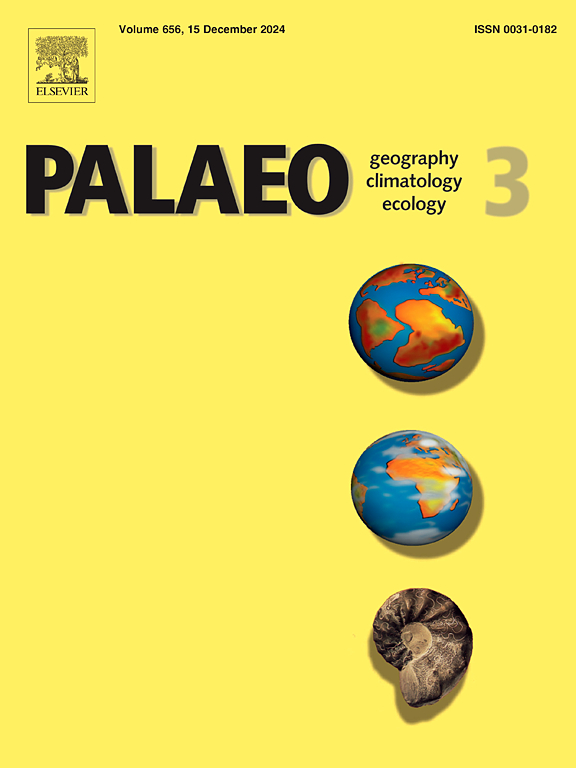滦平盆地下白垩统大北沟组高分辨率磁地层学研究
IF 2.7
2区 地球科学
Q2 GEOGRAPHY, PHYSICAL
Palaeogeography, Palaeoclimatology, Palaeoecology
Pub Date : 2025-05-20
DOI:10.1016/j.palaeo.2025.113021
引用次数: 0
摘要
冀北地区下白垩统大北沟组及其等效地层中包含了热河生物群的早期代表,记录了重要的演化和地质事件,因此受到广泛关注。尽管近年来在古生物学、生物地层学、放射性测年和旋回地层学等方面取得了进展,但对大北沟组的确切年龄仍未达成共识。本文报道了滦平盆地张家沟剖面新的高分辨率磁地层学和详细的岩石磁学结果。岩石磁学结果表明,磁铁矿和灰长岩是特征剩磁的主要载体。通过综合磁地层学和先前公布的SIMS UPb锆石年龄,实现了与地磁极性时间尺度的相关性。磁地层学结果表明,沉积演替从M10Nn亚时开始。3n到亚历元M10Nn。该剖面的年龄可限定为早奥特里夫时期。因此,该演替的基底年龄不迟于132 Ma,为滦平盆地的形成年龄提供了新的约束条件,并为热河生物群早期代表提供了最小年龄估计。这一新发现为整合海相和陆相记录提供了重要依据,并为研究古环境变化及其对热河生物群演化的影响奠定了基础。本文章由计算机程序翻译,如有差异,请以英文原文为准。
High-resolution magnetostratigraphy of the Lower Cretaceous Dabeigou Formation in the Luanping Basin, northern China
The Lower Cretaceous Dabeigou Formation and its equivalent strata in northern Hebei Province, China, are of great interest because they contain early representatives of the Jehol Biota, and record significant evolutionary and geological events. Despite recent advances in paleontology, biostratigraphy, radiometric dating and cyclostratigraphy, there is no consensus about the exact age of the Dabeigou Formation. Here, we report new high-resolution magnetostratigraphy coupled with detailed rock magnetic results from the Zhangjiagou section in the Luanping Basin. Rock magnetic results indicate that both magnetite and greigite are the primary carriers of the characteristic remanent magnetizations. Correlation to the geomagnetic polarity timescale was achieved by integrating magnetostratigraphy and previously published SIMS U![]() Pb zircon ages for the same section. Magnetostratigraphic results show that the sedimentary succession spans from Subchron M10Nn.3n to Subchron M10Nn.1n, and the age of the section can be constrained to the early Hauterivian stage. Therefore, the basal age of this succession is no later than 132 Ma, providing new constraints on the formation age of the Luanping Basin and a minimum age estimate for the early representatives of the Jehol Biota. Our new magnetostratigraphic findings provide important evidence for integrating marine and terrestrial records and further lay a foundation for studying paleoenvironmental changes and their impact on the evolution of the Jehol Biota.
Pb zircon ages for the same section. Magnetostratigraphic results show that the sedimentary succession spans from Subchron M10Nn.3n to Subchron M10Nn.1n, and the age of the section can be constrained to the early Hauterivian stage. Therefore, the basal age of this succession is no later than 132 Ma, providing new constraints on the formation age of the Luanping Basin and a minimum age estimate for the early representatives of the Jehol Biota. Our new magnetostratigraphic findings provide important evidence for integrating marine and terrestrial records and further lay a foundation for studying paleoenvironmental changes and their impact on the evolution of the Jehol Biota.
求助全文
通过发布文献求助,成功后即可免费获取论文全文。
去求助
来源期刊
CiteScore
5.90
自引率
10.00%
发文量
398
审稿时长
3.8 months
期刊介绍:
Palaeogeography, Palaeoclimatology, Palaeoecology is an international medium for the publication of high quality and multidisciplinary, original studies and comprehensive reviews in the field of palaeo-environmental geology. The journal aims at bringing together data with global implications from research in the many different disciplines involved in palaeo-environmental investigations.
By cutting across the boundaries of established sciences, it provides an interdisciplinary forum where issues of general interest can be discussed.

 求助内容:
求助内容: 应助结果提醒方式:
应助结果提醒方式:


